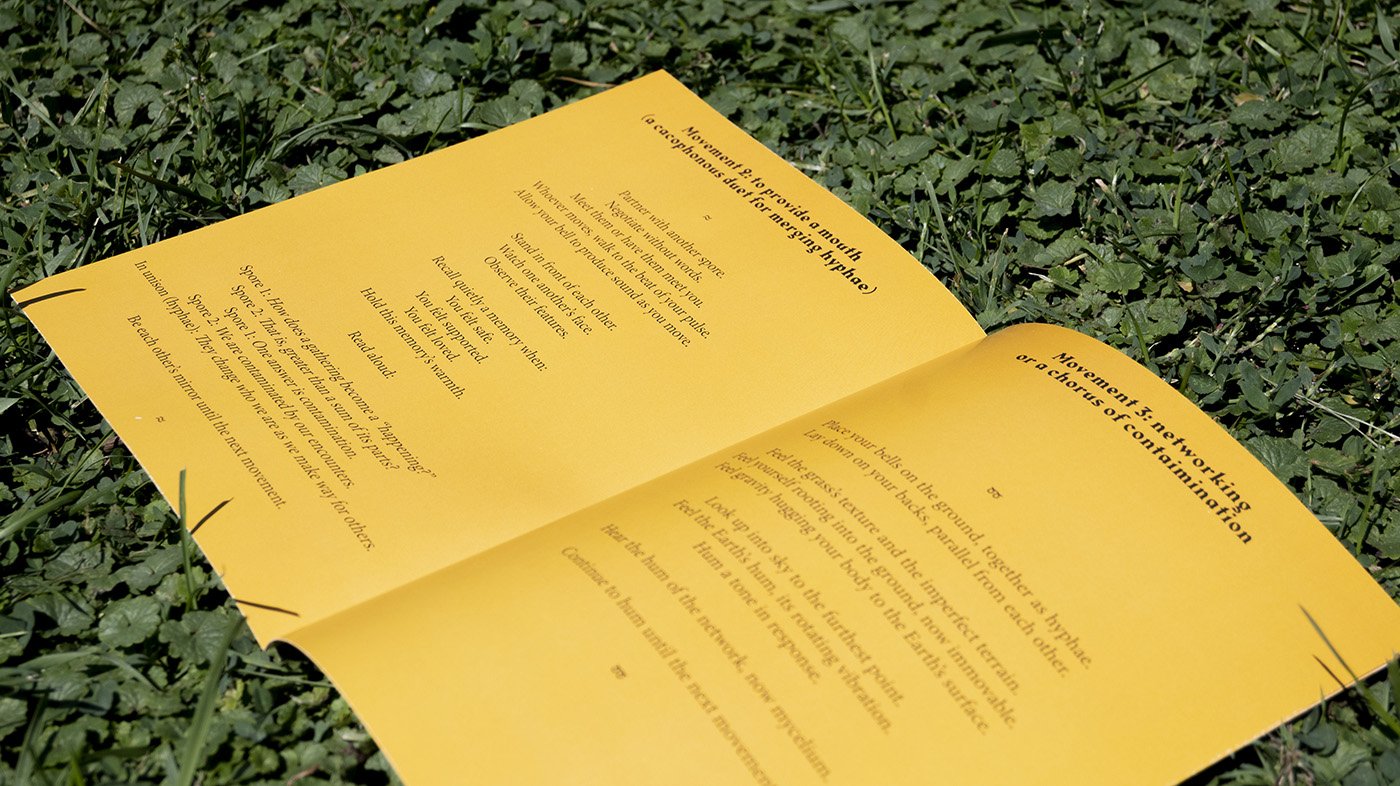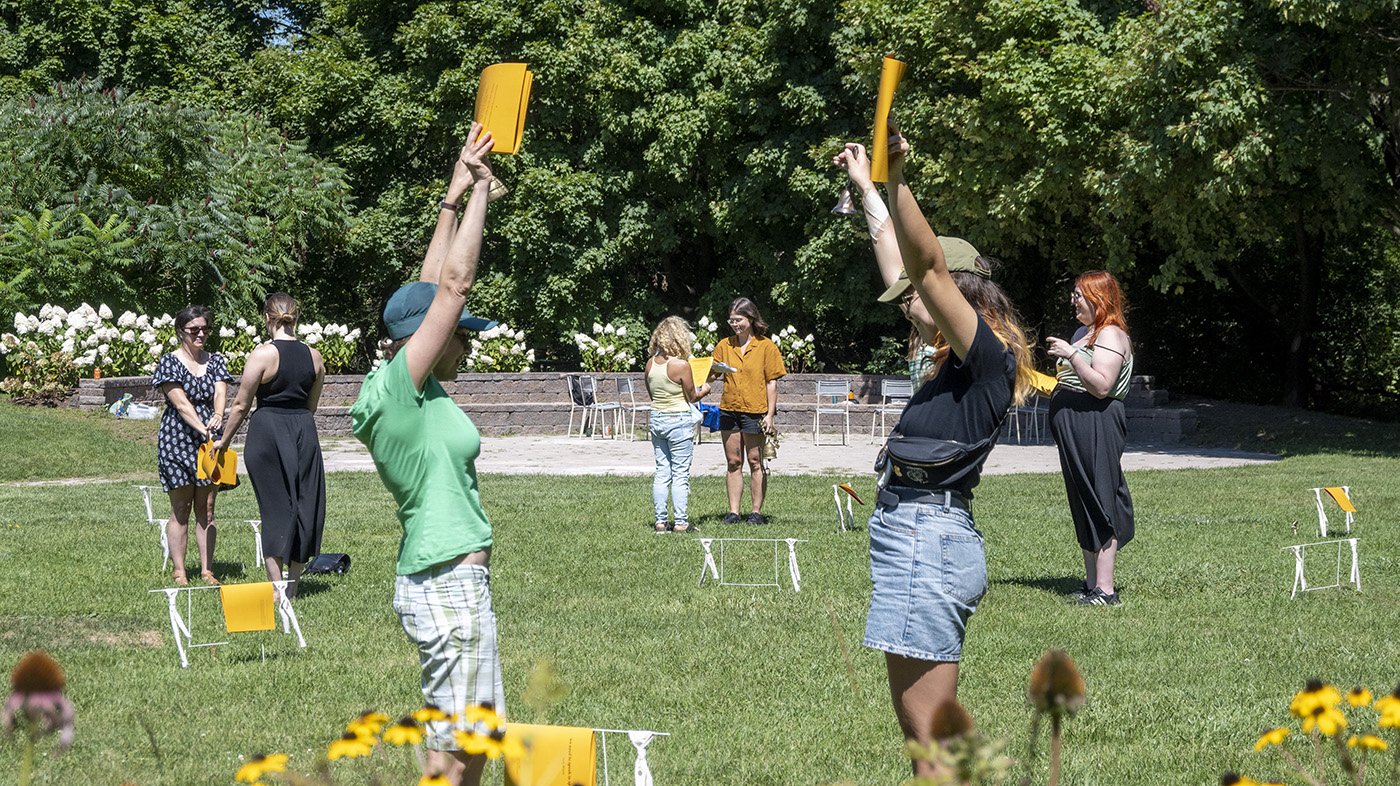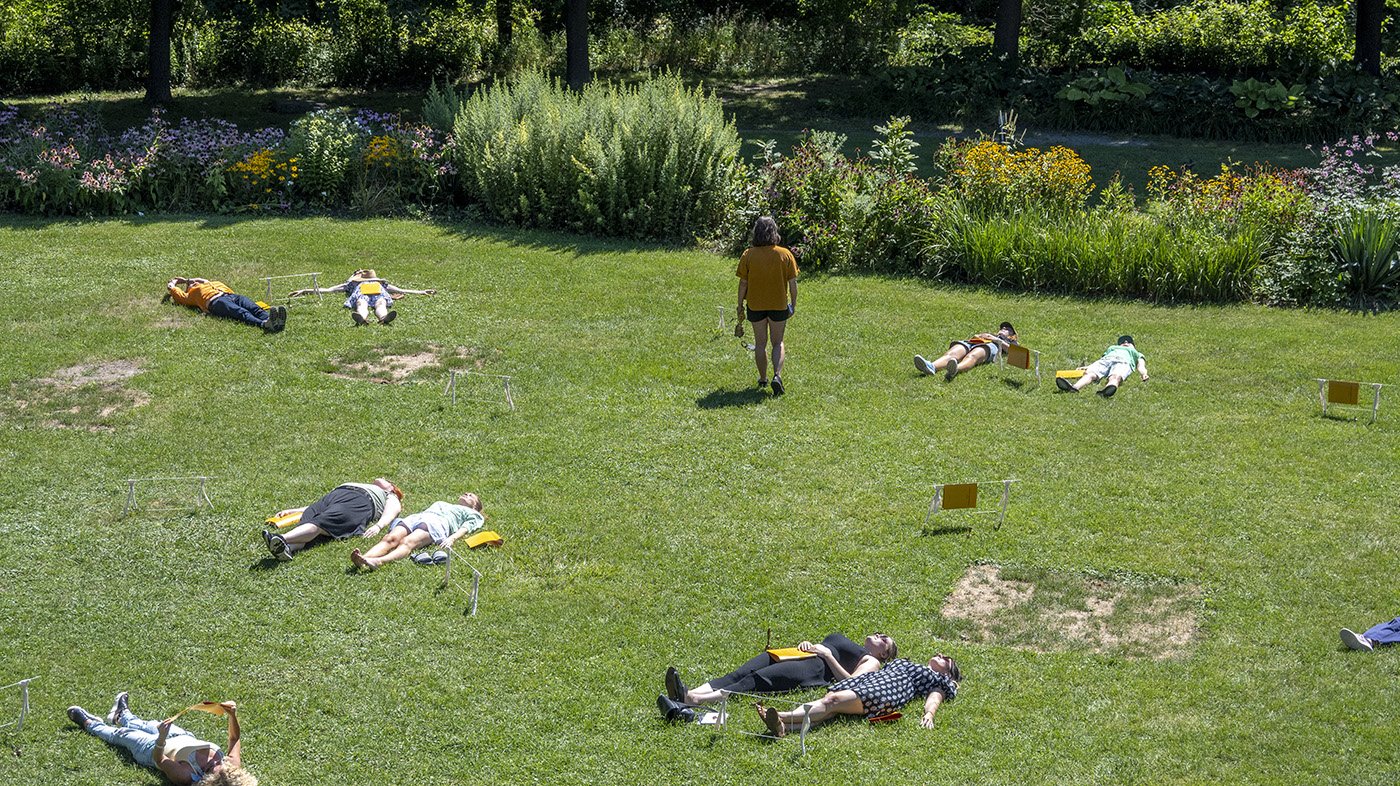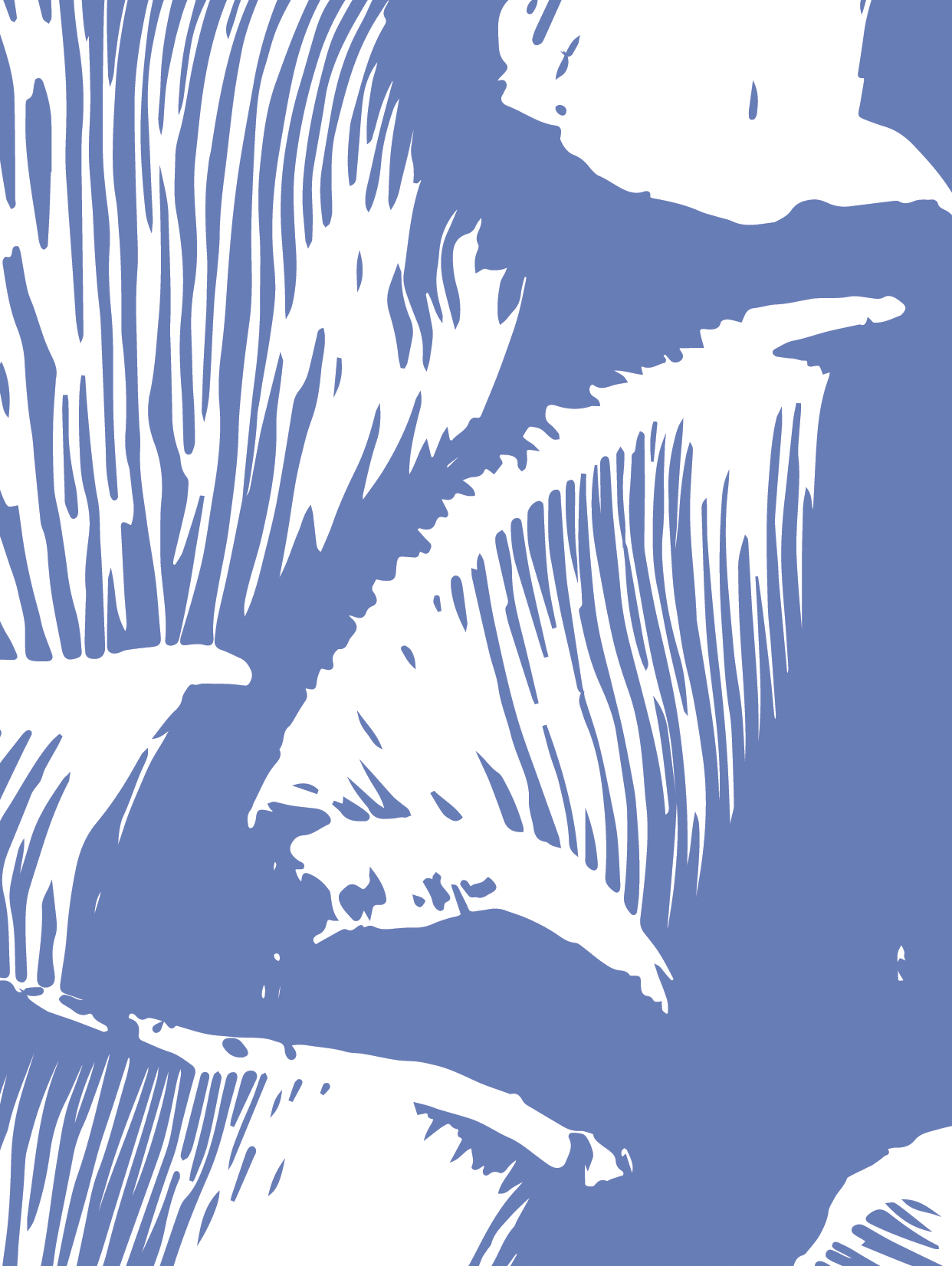
Sahar Te: Incubator
October 10 - November 7, 2021
As the seasons change and decay of our prolonged year catalyzes. Installed in the VAC Loft Gallery, Sahar Te (with the fabrication and sculptural hand of Nicolas Fleming) situate Incubator, a mushroom incubator that demonstrates and teaches alternative-adaptive models of community care and growth. Encouraging others to bear witness and internalize the processes of mushroom growth and prosperity, Te proposes that we adopt mycelial systems of progress and knowledge proliferation to mobilize radical systemic change.
Mushrooms uniquely set the precedent of enriching life, and bringing new life, through the abolition of dead systems, a cycle that we need to bring to light and adopt. Inspired by mycelial networks, Sahar Te invites the community to join in sharing their knowledge, traditions, and voices to develop a radical discourse that is responsive to, and critical of, the connotations of community, collaboration, and care within the arts. Through the mushroom incubator, Te will introduce the public to systems of care and support as inspired by mushrooms as collaborative organisms; as problem solvers; as adaptive and conscious communicators; and as hosts to networks of exchange. How can we adopt their methodologies; and how can we resist ideas of how community organizing ought to be, and participate in a dialogue with the community to facilitate this change?
Similar to mushrooms, our knowledge perforates the walls of the gallery and permeates the community. As a community, proliferate and become invasive to normalcy. As a supplement to the physical space of the incubator, Te brings the voices of: Meech Boakye, August Klintberg, Emily DiCarlo, Craig Fahner, JP King, Chris Mendoza, Liam Mullen, Matt Nish-Lapidus, Miles Rufelds, and Tosca Téran together to guide us as we navigate systems of knowledge and engage in radical collaborative projects and workshops to build and share new knowledge that focus on systems of care, alternative communication networks, and the resistance of tradition.
Exhibition Text
Belinda Kwan | 关浩恩 is a Chinese-Canadian settler curator interested in exhibitionary forms of critique, pedagogy, and advocacy. Her research-based practice explores how processes of knowledge translation and legitimization respond to transgenerational trauma. More recently, her work has focused on how notions of scientific and mathematic ‘objectivity’ shape the socio-political imaginary. She has curated the work of locally and internationally-known artists for the Society of Literature, Science, and the Arts (US/Canada); Varley Art Gallery (Markham); InterAccess (Toronto); Art Gallery of York University (Toronto); and Myseum of Toronto. Her projects have been featured in Canadian Art and CBC Arts. Currently, Kwan is a Co-Director at Bunker 2 Contemporary Art Container and an executive board member of Trinity Square Video (Toronto).
Incubator Workshop Series
Sahar Te, August Klintberg, Emily DiCarlo, Miles Rufelds
August 27 and September 9, 2022
The Incubator Workshop Series is proudly supported by
August Klintberg, Emily DiCarlo, and Miles Rufelds return to the Visual Arts Centre of Clarington (VAC) to culminate Sahar Te’s Incubator exhibition project with a series of in-person workshops related to the fantastic potential of mushrooms. Te’s installation was part of an exhibition series, wholly titled Public Space, at the VAC in 2021. Founded on public and cultural collaboration, the series invited artists to lead participatory exhibition installations supported by community-focused programmes. Throughout August, the artists invite participants to engage in collective group happenings related to the fantastic potential of mycelium growth and collaboration. Included is a participatory performance with Emily DiCarlo, Miles Rufelds’ short film screenings at the VAC and a virtual discussion with August Klintberg.
A free shuttle bus will depart Toronto from Factory Theatre, 125 Bathurst St., Toronto, ON, M5V 2R2 at 10:30 am to bring out-of-town visitors to the VAC for the day’s events. Signing up for the shuttle bus includes registration in both workshops.
-

We need to speak in spores
Participatory performance
Saturday, August 27, 2022, 12 - 2 pmWe need to speak in spores is a collective exercise in attunement, empathy and collaboration where the public is invited to think like fungi. Taking place outside the Visual Arts Centre of Clarington (VAC), participants will be presented with an “event score” — a set of simple instructions that will prompt a series of group actions, meditations, and thought experiments to explore the emergent effects of encounter.
In her book The Mushroom at the End of the World: On the Possibility of Life in Capitalist Ruins, Anna Lowenhaupt Tsing discusses the mycelial potential of the “assemblage,” an open-ended gathering that holds the possibility of becoming a “happening,” where the collective’s power, ability and imagination become greater than the sum of their parts. She argues that this transformation can only occur through contamination and says, “we are contaminated by our encounters; they change who we are as we make way for others. As contamination changes world-making projects, mutual worlds —and new directions— may emerge.”
Taking cues from fungi’s integral role in a forest’s health, such as facilitating interspecies communication and resource distribution, the participatory event will repurpose a selection of research papers, essay selections, news stories, poems, mythologies and will “compost” previous artistic elements from Sahar Te’s curatorial program Incubator, originally installed in the VAC Loft Gallery in fall 2021. Through a process of exchanged “assembled contaminations,” participants will discover and co-produce their own collective, attuned language.
* To participate in this event, no previous performance experience is required.
-

Saprotrophs
Screening and presentation
Saturday, August 27, 2022, 2 - 4 pmSaprotrophs is a hybrid screening and lecture event to be presented at the Visual Arts Centre of Clarington, focused on historicizing ideas of growth and decay, as they’ve evolved from the earth’s ancient ecologies to landscapes of industrialized capitalism. The word saprotroph refers to species of plant, animal, or (most commonly) fungus that survive by feeding on the dead remains of living creatures. Mediating ecological processes of growth and decay, saprotrophs have sustained the earth’s development by balancing historical ratios of additional and subtraction, accumulation and attenuation.
The event will open with a screening of artist Miles Rufelds’ 2019 essay film, Two or Three Saprophytes. Tonally pitched between Marxist ecological criticism and European Gothic horror, the film tells a hallucinatory narrative of mushrooms, chemicals, machines, and ghosts, contrasting a speculative history of the Industrial Revolution with a broader analysis of the earth’s patterns of growth, decomposition, and fossilization.
Following the film screening, Rufelds will present a new piece of writing, expanding on themes brought up in the film, focusing specifically on contemporary questions surrounding the limits of capitalist growth, contested notions of “degrowth,” ecological activism, and labour agitation.
The screening will be followed by a Q&A and open discussion with the audience.
-

A Virtual Meeting
Where: Zoom, a live recording will be made available.
Friday, September 9, 6:30 pmAugust Klintberg leads a virtual discussion studying the phenomenon of artist-run restaurants—the subject of his Ph.D. thesis and a remaining area of ongoing research in his practice. Klintberg’s selected case studies use food and hospitality as leverage points to highlight commodity exchange, to enact activism, to question or claim forms of identity, and to spark conviviality.
Click here to access the YouTube recording






Spore Protocol
By Craig Fahner
Spore Protocol is an experimental web server whose means of access aims to replicate the symbiotic action of fungi. Just as mycelia thrive by simultaneously taking and providing, this speculative alternative model of internet communication only provides information to the user once it has been given information by the user. Spore Protocol presents itself to users as a Wi-Fi network within the gallery space. When a userjoins on their mobile device, they will be prompted to first provide something to the server from a list of prompts: a feeling, a sound, a colour, etc. In exchange, the user is provided an assemblage of other contributions, collaged into a sort of living emotional history of what has occurred in the gallery space. In facilitating the exchange of these simple, esoteric prompts, Spore Protocol aims to render a poetic form of communication based on contribution rather than consumption. Ultimately, the project aims to provoke audience members to consider forms of communication, such as those found in mycological systems, which might serve as alternatives to the provider-consumer hierarchies typical to most contemporary digital communication platforms.




Hyperflush
By Meech Boakye
Right now, it is quiet. I am your body and you are mine. Our limbs are being re-cast into filaments. We are existing together, as togetherness, the embodiment of it all. I cannot express in this moment how much the residue of your body means to mine. This celestial bloom of transness: a brief (crucial) moment of intense relation. We have found some way of living in our body even in death, even in our afterwords. I know that I have been here before. I know I am returning.
Prose portal entryway to a mycological letter/ritual/recipe/dream for cyborg me and other beings like us.
Recipes, Spores
and Edible Myths
notes on cooking
edited by Chris Mendoza
with contributions by Léonie Beaulieu, Holly Fedida, Ben Montague,
Jamie Potvin and Hannah Scanlon
The “recipes” in this book are contributions from people who are makers; who are dear friends; who I have cooked for; who have cooked for me, or with me; and with whom I share a love for food. They come from picking up our ongoing conversations over food. This is a collection of recipes, but really it is a book of conversations. Or rather, it offers the recipe as a fruit of conversation, a pointer to larger networks below.

Compos(t)ing
November 6, 1:30pm-3pm
*To accommodate those who are unable to be in attendance physically, the event will be accessible to the public as a video on this webpage after the performance.*
As a continuation of the Public Space project, Sahar Te invites JP King and Matt Nish-Lapidus to host an experimental sonic dialogue at the VAC’s Loft Gallery. Compos(t)ing challenges the behaviour of communication networks through the use of modular synthesizers and software that mimic and take inspiration from mycelial networks. Join us in celebrating the closure of Te’s installation, as King and Nish-Lapidus prepare a fertile bed to lay Te’s mycelial conversations to peaceful hibernation over the winter months.
A song is an ephemeral gesture of a musician, and similarly, a mushroom is the discrete fruiting body of mycelium. Such momentary and exuberant expressions hint at a unique process of distribution and decay. King and Nish-Lapidus have chosen to respond to Public Space by modelling a series of experimental sound performances based upon decentralized fungal forms. These two artist-composers will compost found sound, chatter, dialogue, and field recordings from the exhibition environment in an effort to create something entirely new.
King’s recombinatory practice centers around a modular system designed to layer, process, and resample the human voice. The resulting sedimentations of sound are aimed at producing a coincidental and fertile dialogue addressing the exhibition themes. For Nish-Lapidus, foraging the incidental sounds of the gallery is akin to a walk in the woods. Propagating these sonically sampled morsels, Nish-Lapidus applies a fungi-cultural methodology to a code that mirrors the actions of mycelial structures. The result is an assemblage response to the environments surrounding the Loft Gallery.
Democratizing Mushroom Cultivation
Oct 8, 2021, 7-8:30pm
Terán invites the public to participate in learning how to grow your own mushrooms with household items.
Community members and the general public are invited to contribute to Te’s larger project which will see the Loft space transformed into a growing Oyster mushroom incubator. In this workshop Terán will introduce participants to the fantastic potential of mycelium for collaboration at the intersection of art and science. Participants will learn how to cultivate mycelium affordably towards use as a bio-material and/or food, while also having the option to add towards the project’s larger site-specific installation of edible, free, and takeable Oyster mushrooms until November 7.
Participants will be introduced to sterile and non-sterile techniques, suggestions and inspirations for working with various armatures (3D printed, hand-knit/crocheted, wood structures, etc), as well as sculpting and forming with mycelium as a demonstration. Mycelium can be used in industrial design, art, fashion, architecture - the possibilities are seemingly endless!
Artist Biographies
Sahar Te is a Toronto-based artist and writer whose practice exists at the intersection of text, installation, and performance. Her practice mobilizes methods that open up alternative realities and confront convention. Her multidisciplinary interest in sociology, politics, theatre, literature, and acoustics inform her research-based projects. Te’s interventions range from language and semiotics, social dynamics and ethics, to media studies and oral histories. Her projects engage in socio-political and techno-political discourses to understand hegemony within different power structures. Her site-specific public works focus on counter-monuments, collective memory, and political contemplation.
Te obtained her Bachelor’s of Fine Arts from the Alberta University of Arts and her Master’s of Fine Arts from the University of Toronto. Her work and writing have been exhibited and published both nationally and internationally.
Meech Boakye is an artist and illustrator engaging with ancestral practices of food preservation and bioplastic material research as rituals of care and remediation. Ongoing works exist in a mutable archive, slowly digesting in stomachs or decomposing in piles of hot compost, existing as conduits for cyborgian thought and armatures for healing from extractive landscapes.
August Klintberg is a queer artist who works in the field of art history. He is an Associate Professor at the Alberta University of the Arts. He was shortlisted for the Sobey Art Award in 2013. Public and private collections across Canada and in the United States - including the National Gallery of Canada, the Edmonton Arts Council, and the Alberta Foundation for the Arts - have acquired his work. His work has recently been shown at Latitude 53 (Edmonton), the Dunlop Art Gallery (Regina), the Art Gallery of Nova Scotia (Halifax), the Art Gallery of Alberta (Edmonton), the Illingworth Kerr Gallery (Calgary), AXENÉ07 (Gatineau), and Trapdoor Artist Run Centre (Lethbridge). Other exhibitions featuring his work have taken place at Locust Projects (Miami), the National Gallery of Canada (Ottawa), the Banff Centre, Centre des arts actuels Skol (Montreal), The Harbourfront Centre (Toronto), and Eastern Edge (St. John's), Alberta Biennial 2017 and at Fruitmarket Gallery (Scotland).
Emily DiCarlo is an artist and writer whose interdisciplinary practice considers site, temporality and collaboration as the foundational principles for meaning-making. Evidenced through installation, video, performance and text, her work connects the infrastructure of time with the intimacy of duration. Since 2016, she has served as the Communications Officer for the International Society for the Study of Time. Her work has been shown both locally and abroad, with recent exhibitions at the Art Museum, Toronto and SÍM Gallery in Reykjavik, Iceland as part of its artist-in-residence program. She recently held a Canadian Social Sciences and Humanities Research Council (SSHRC) grant.
Craig Fahner is an artist and musician from Calgary. Fahner’s media artworks examine the politics and poetics of invisible digital infrastructures. His works have been exhibited in various venues and festivals internationally, including the 2017 Alberta Biennial, the Museo de la Ciudad in Queretaro, Mexico, and the Device Art Triennial in Zagreb. He is currently a PhD candidate in the Joint Program in Communication & Culture at York and X Universities.
JP King is an artist, designer, and educator with a research-based multimedia practice focused on waste, material culture, creative systems, visual communication, sound, and storytelling. He produces prints, videos, and participatory learning experiences. Nominated for a Governor General's Innovation Award in 2016, King's research has received support from The Canada Council, SSHRC, The Banff Centre. He holds an MFA in Interdisciplinary Art, Media, and Design from OCAD U. He currently teaches at the University of Toronto Daniels Faculty of Architecture, Landscape and Design and lives with his wife and collaborator, Kirsten McCrea, in Toronto.
Chris Mendoza lives and works in Tkaronto/Toronto. Chris’ work moves between performance, sculpture, image-based work, and writing as affective inquiries into belonging, inheritance, and embodied relations to place. Chris values presenting and performing work both in and outside of formal art spaces—the former includes the University of Toronto Art Gallery (2021); Craft Ontario (2019); Crutch Gallery (2019); FOFA gallery (2018); and the Icelandic Textile Center (2018). Chris holds a BFA from Concordia University and a Master of Visual Studies from the University of Toronto.
Liam Mullen is an artist, writer, and researcher studying at the University of Toronto's John H. Daniels Faculty of Architecture, Landscape, and Design’s Visual Studies department. Currently, his research is oriented toward understanding the relationships between land and sound as a way to ethically ‘unearth' discreet-sedimented sonic artefacts. Through speculative methods of data-representation, Mullen weaves aural, written, and lens-based media together to articulate the difficulties in attuning with the immaterial and that which is incommensurable.
Matt Nish-Lapidus is an artist, writer, musician, and designer. He makes software, sounds, and texts probing the myth that computers need to be useful rather than beautiful. Matt’s interests lie in the poetics of computation and its proclivity to create meaningful relations through iteration and recombination. His work often results in diverse outputs including books, recordings, installations, performances, software, and objects. You can find Matt online and away-from-keyboard under various aliases and collaborations including emenel, New Tendencies, må, and <blink>.
Miles Rufelds is an artist, writer, and filmmaker based in Toronto. He holds a Master of Visual Studies in studio art from the University of Toronto, and a Bachelor of Fine Arts from the University of Ottawa. With emphasis on investigative research, conceptualism, and experimental forms of storytelling, Rufelds’ projects explore the braided histories of political economy, technology, and aesthetics. Rufelds has exhibited nationally and internationally, including the Art Museum at the University of Toronto, the Blackwood Gallery, the Karsh-Masson Gallery, PAVED Arts, Union Station, and SIM Gallery in Rejkyavik. Rufelds is also co-founder and co-director of Toronto gallery ‘the plumb.’
Tosca Terán describes herself as an interdisciplinary, human holobiont, whose work is a confluence of art, ecology, and craft. Her work has been featured at The Harwood Museum, SOFA New York, The Toronto Design Exchange, MOCA Toronto, The Ontario Science Centre, Music Works, Vector Festival, Studio Art & Craft Canada, SONICA21, Glasna Music Magazine, The Mushroom UK, NAISA (New Adventures In Sound Art), Ars Electronica and cited by NASA Ames Research center. Awarded funding support and residencies from the Goethe-Institut Montreal, The Canada Arts Council, BigCi Environmental Award Australia, Ontario Arts Council, the Toronto Arts Council, and Coalesce Centre for Biological Art for her immersive, nonhuman bio-sonification projects.






